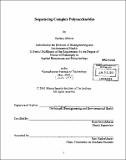| dc.contributor.advisor | Ram Sasisekharan. | en_US |
| dc.contributor.author | Shriver, Zachary (Zachary Holmes), 1973- | en_US |
| dc.contributor.other | Massachusetts Institute of Technology. Division of Bioengineering and Environmental Health. | en_US |
| dc.date.accessioned | 2005-06-02T15:32:51Z | |
| dc.date.available | 2005-06-02T15:32:51Z | |
| dc.date.copyright | 2001 | en_US |
| dc.date.issued | 2001 | en_US |
| dc.identifier.uri | http://hdl.handle.net/1721.1/17515 | |
| dc.description | Thesis (Ph. D.)--Massachusetts Institute of Technology, Division of Bioengineering and Environmental Health, 2001. | en_US |
| dc.description | Includes bibliographical references (leaves 136-140). | en_US |
| dc.description.abstract | Glycosaminoglycans are complex polysaccharides that exist at the cell/extracellular matrix interface. As such, these information-dense molecules are key regulators of extracellular signals. However, to date, there has been a lack of effective biochemical and analytical tools for the analysis of glycosaminoglycan structure and hence, there is very little understanding of exactly how glycosaminoglycan structure impinges on function. Development of such tools is especially important for a key subset of glycosaminoglycans, i.e., heparin/heparan sulfate-like glycosaminoglycans (HLGAGs). As a first step in the development of tools to study HLGAG structure, biochemical studies were completed on the heparinases, a family of three HLGAG-degrading enzymes from Flavobacterium heparinum. With heparinase I, it was found that calcium is a necessary cofactor for optimal activity and that two putative calcium coordinating motifs exist in heparinase I. With heparinase II, a single cysteine and three histidines were found to be critical for proper enzymatic function. Finally, with heparinase III, two histidines were found to be catalytically important. | en_US |
| dc.description.abstract | (cont.) In addition to the development of the heparinases, sensitive analytical methodologies were developed to determine HLGAG structure. A novel mass spectrometric procedure was developed and used to define heparinase's II mechanism of action on defined oligosaccharide substrates. In addition, capillary electrophoresis, in combination with heparinase digestion, was used for the compositional analysis of HLGAG oligosaccharides. Coupling of these analytical techniques with a property-encoded nomenclature to handle the information density of HLGAGs enabled the development of a sequencing procedure for HLGAGs. These procedures were then used to probe a number of key biological processes that are mediated by HLGAGs. The sequencing approach developed herein was used to determine the structure of HLGAG oligosaccharides involved in hemostasis and viral binding. In addition, these approaches were used to probe HLGAG binding by clinically and biologically important signaling molecules, viz., fibroblast growth factor and endostatin. Together, these studies represent a foundation with which it possible to develop further HLGAG structure/function relationships, opening new avenues of research and making possible HLGAG-based therapeutics. | en_US |
| dc.description.statementofresponsibility | by Zachary Shriver. | en_US |
| dc.format.extent | 140 leaves | en_US |
| dc.format.extent | 15464392 bytes | |
| dc.format.extent | 15464198 bytes | |
| dc.format.mimetype | application/pdf | |
| dc.format.mimetype | application/pdf | |
| dc.language.iso | eng | en_US |
| dc.publisher | Massachusetts Institute of Technology | en_US |
| dc.rights | MIT theses are protected by copyright. They may be viewed, downloaded, or printed from this source but further reproduction or distribution in any format is prohibited without written permission. | en_US |
| dc.rights.uri | http://dspace.mit.edu/handle/1721.1/7582 | |
| dc.subject | Division of Bioengineering and Environmental Health. | en_US |
| dc.title | Sequencing complex polysaccharides | en_US |
| dc.type | Thesis | en_US |
| dc.description.degree | Ph.D. | en_US |
| dc.contributor.department | Massachusetts Institute of Technology. Division of Bioengineering and Environmental Health | en_US |
| dc.contributor.department | Massachusetts Institute of Technology. Department of Biological Engineering | |
| dc.identifier.oclc | 49562076 | en_US |
